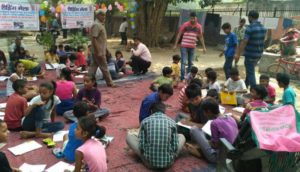On reading melas and more
Reading melas are being organised by the Delhi government in a bid to improve literacy. These are being promoted  with ads and radio spots but the intention is more political. (http://bit.ly/2fgsCEm ) There is no insight into the methodology except teachers taking vows publicly to help their students read by 14 Nov, Children’s Day. How can children who have not been taught properly so far learn their letters and some kind of reading fluency within days? Surely there has to be a more structured programme rolled out involving publishers and authors along with the educators and politicians too, to create and provide books that assist learning and develop a love for reading. Publishers of children’s literature have developed a science of creating levelled readers that are divided into nonfiction and fiction. Publishers like OUP provide the ORT school packs that are technically sound on phonetics and teach children. Likewise NCERT, NBT, CBT, AWIC, Pratham Books, Tulika and Katha have titles in Indian languages that could be introduced as supplementary material and classroom educational aids.
with ads and radio spots but the intention is more political. (http://bit.ly/2fgsCEm ) There is no insight into the methodology except teachers taking vows publicly to help their students read by 14 Nov, Children’s Day. How can children who have not been taught properly so far learn their letters and some kind of reading fluency within days? Surely there has to be a more structured programme rolled out involving publishers and authors along with the educators and politicians too, to create and provide books that assist learning and develop a love for reading. Publishers of children’s literature have developed a science of creating levelled readers that are divided into nonfiction and fiction. Publishers like OUP provide the ORT school packs that are technically sound on phonetics and teach children. Likewise NCERT, NBT, CBT, AWIC, Pratham Books, Tulika and Katha have titles in Indian languages that could be introduced as supplementary material and classroom educational aids.
 London-based publisher, Reem Makhoul, of Ossass gave a tremendous interview to Marcia Lynx Qualey, ArabLit on children’s literature where Reem says they wanted to give the children what they are familiar with, so began creating beautiful books in colloquial Arabic. Read on: http://bit.ly/2eMP5Zi Amazon too seeing the potential of a reading habit has launched an app for children – Amazon Rapids ( http://bit.ly/2fEw10j) As the Scottish Book Trust has stressed creating a working place reading culture can have a positive impact on businesses too but the habit has to be created earlier. (http://bit.ly/2fgsnsW) Recently the Financial Times listed a series of smartphone reading apps or a mobile library such as The Pigeonhole, Alexi and Oolipo: http://on.ft.com/2fErn0A
London-based publisher, Reem Makhoul, of Ossass gave a tremendous interview to Marcia Lynx Qualey, ArabLit on children’s literature where Reem says they wanted to give the children what they are familiar with, so began creating beautiful books in colloquial Arabic. Read on: http://bit.ly/2eMP5Zi Amazon too seeing the potential of a reading habit has launched an app for children – Amazon Rapids ( http://bit.ly/2fEw10j) As the Scottish Book Trust has stressed creating a working place reading culture can have a positive impact on businesses too but the habit has to be created earlier. (http://bit.ly/2fgsnsW) Recently the Financial Times listed a series of smartphone reading apps or a mobile library such as The Pigeonhole, Alexi and Oolipo: http://on.ft.com/2fErn0A
The desire to blend technology and reading has resulted in some remarkable innovations such as WIPO’s cutting-edge translation tool based on “artificial intelligence”. It renders highly technical patent documents into a second language in a style and syntax that more closely mirrors common usage, out-performing other translation tools built on previous technologies. It is called neural machine translation, an emerging technology. It is based on huge neural network models that “learn” from previously translated sentences. The specificity of neural machine translation (compared to previous “phrase based” statistical methods) is that it produces more natural word order, with particular improvements seen in so-called distant language pairs, like Japanese-English or Chinese-English. ( http://bit.ly/2eEqm65 )
11 Nov 2016

No Comments